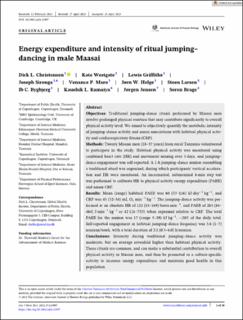| dc.contributor.author | Christensen, Dirk L. | |
| dc.contributor.author | Westgate, Kate | |
| dc.contributor.author | Griffiths, Lewis | |
| dc.contributor.author | Sironga, Joseph | |
| dc.contributor.author | Maro, Venance P. | |
| dc.contributor.author | Helge, Jørn W. | |
| dc.contributor.author | Larsen, Steen | |
| dc.contributor.author | Bygbjerg, Ib C. | |
| dc.contributor.author | Ramaiya, Kaushik L. | |
| dc.contributor.author | Jensen, Jørgen | |
| dc.contributor.author | Brage, Søren Karl | |
| dc.date.accessioned | 2023-10-17T09:25:35Z | |
| dc.date.available | 2023-10-17T09:25:35Z | |
| dc.date.created | 2023-05-31T13:40:36Z | |
| dc.date.issued | 2023 | |
| dc.identifier.citation | American Journal of Human Biology. 2023, 35(9), Artikkel e23907. | en_US |
| dc.identifier.issn | 1042-0533 | |
| dc.identifier.uri | https://hdl.handle.net/11250/3096929 | |
| dc.description | This is an open access article under the terms of the Creative Commons Attribution-NonCommercial-NoDerivs License, which permits use and distribution in any medium, provided the original work is properly cited, the use is non-commercial and no modifications or adaptations are made. | en_US |
| dc.description.abstract | Objectives: Traditional jumping–dance rituals performed by Maasai men involve prolonged physical exertion that may contribute significantly to overall physical activity level. We aimed to objectively quantify the metabolic intensity of jumping–dance activity and assess associations with habitual physical activity and cardiorespiratory fitness (CRF).
Methods: Twenty Maasai men (18–37 years) from rural Tanzania volunteered to participate in the study. Habitual physical activity was monitored using combined heart rate (HR) and movement sensing over 3 days, and jumping–dance engagement was self-reported. A 1-h jumping–dance session resembling a traditional ritual was organized, during which participants' vertical acceleration and HR were monitored. An incremental, submaximal 8-min step test was performed to calibrate HR to physical activity energy expenditure (PAEE) and assess CRF.
Results: Mean (range) habitual PAEE was 60 (37–116) kJ day−1 kg−1, and CRF was 43 (32–54) mL O2 min−1 kg−1. The jumping–dance activity was performed at an absolute HR of 122 (83–169) beats·min−1, and PAEE of 283 (84–484) J min−1 kg−1 or 42 (18–75)% when expressed relative to CRF. The total PAEE for the session was 17 (range 5–29) kJ kg−1, ~28% of the daily total. Self-reported engagement in habitual jumping–dance frequency was 3.8 (1–7) sessions/week, with a total duration of 2.1 (0.5–6.0) h/session.
Conclusions: Intensity during traditional jumping–dance activity was moderate, but on average sevenfold higher than habitual physical activity. These rituals are common, and can make a substantial contribution to overall physical activity in Maasai men, and thus be promoted as a culture-specific activity to increase energy expenditure and maintain good health in this population. | en_US |
| dc.language.iso | eng | en_US |
| dc.subject | cardiorespiratory fitness | en_US |
| dc.subject | CRF | en_US |
| dc.subject | dance | en_US |
| dc.subject | energy expenditure | en_US |
| dc.subject | jumping | en_US |
| dc.subject | male | en_US |
| dc.subject | men | en_US |
| dc.subject | Maasai | en_US |
| dc.subject | physical activity | en_US |
| dc.subject | Tanzania | en_US |
| dc.title | Energy expenditure and intensity of ritual jumping–dancing in male Maasai | en_US |
| dc.type | Peer reviewed | en_US |
| dc.type | Journal article | en_US |
| dc.description.version | publishedVersion | en_US |
| dc.rights.holder | © 2023 The Authors | en_US |
| dc.source.pagenumber | 10 | en_US |
| dc.source.volume | 35 | en_US |
| dc.source.journal | American Journal of Human Biology | en_US |
| dc.source.issue | 9 | en_US |
| dc.identifier.doi | 10.1002/ajhb.23907 | |
| dc.identifier.cristin | 2150461 | |
| dc.description.localcode | Institutt for fysisk prestasjonsevne / Department of Physical Performance | en_US |
| dc.source.articlenumber | e23907 | en_US |
| cristin.ispublished | true | |
| cristin.fulltext | original | |
| cristin.qualitycode | 1 | |
